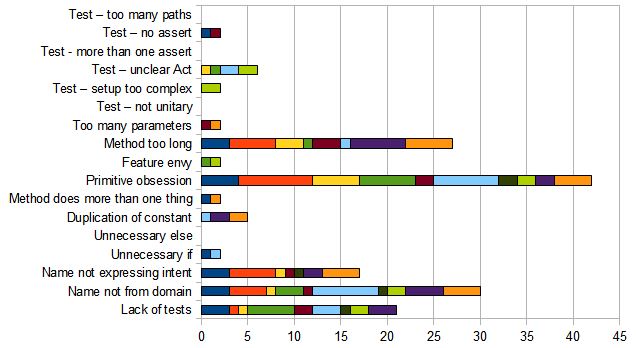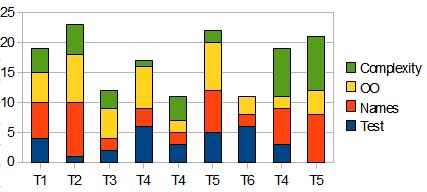 Code Smells
Code SmellsCode smells are hints that show you potential problems in your code. They are heuristics: Like in real life, if something smells, look at it, think about it, and change it if necessary. In the classic book Refactoring - Improving the Design of Existing Code, Martin Fowler describes 21 code smells like Long Method, Primitive Obsession, Switch Statements, Feature Envy and other anti-patterns that indicate deeper problems in your code.
The Brutal Refactoring Game
Adrian Bolboaca came up with the Brutal Refactoring Coding Game. He explained the history of the game and the game itself on his blog. I attended his workshop at the XP conference 2013 and experienced the game first hand.
In the game participants are asked to write the cleanest code possible. If the facilitator spots any code smell, participants must stop and immediately remove it. Adding functionality is forbidden until the facilitator agrees that the smell has been removed. In his workshop, Adi gave us a numbered list of smells and gave cards with the appropriate number to pairs where he saw a code smell. And he was mercilessly flagging the smallest problems in our code. ;-)
Code Smells Used in the Game
Adi chose these code and test smells for his game:
- Lack of tests
- Name not from domain
- Name not expressing intent
- Unnecessary
if - Unnecessary
else - Duplication of constant
- Method does more than one thing
- Primitive obsession
- Feature envy
- Method too long (has more than six lines)
- Too many parameters (more than three parameters)
- Test is not unitary
- Test setup too complex
- Test has an unclear Act
- Test has more than one assert
- Test has no assert
- Test has too many paths
Observations during the Brutal Refactoring Game
This article is not about the Brutal Refactoring Game, but about code smells introduced into code. The game allows observation how and when code smells are introduced (because the whole point is to spot and remove them). As part of my refactoring training I facilitated the game more than ten times. Each time took 3 to 5 hours and had six to eight participants. The teams were average teams with several senior developers and an occasional junior developer. People worked in pairs and implemented Tic-Tac-Toe. Most teams used Java, two teams used C.
Discussion of Introduced Code Smells
Here is the code smells statistic:

The chart shows the number of problems I flagged during the last ten games. The different colours of the bars show the different teams. Obviously not all smells are introduced equally often. The first smells appear 10 to 15 minutes into the exercise. One team using C had difficulties with the setup and was going forward very slow - they produced little code and very few smells.
The first smell I usually see is 1 - Lack of tests. Even people following the TDD cycle happen to create "more production code than is sufficient to pass the test." This happens in the beginning and also later during the game.
Naming is hard. Not surprisingly the most common smells (number two - Name not from domain - and number three - Name not expressing intent) are naming related. Naming things after the problem domain seems twice as hard as pure technical naming. Any non trivial method could be named
process or execute, but that does not help understanding the code at all.Primitive Obsession (number eight) is the most common single code smell I have seen during the game. It is introduced early in development when method signatures are created and APIs are designed. It occurs roughly as often as the naming related smells together. Most Tic-Tac-Toe implementations are (publicly) based on numbers, pairs of numbers, arrays of numbers or the like. Primitive Obsession is very dominant in many (Java) code bases. In my code reviews I am used to method argument lists like
String, String, String, String, String, int, long, long etc. Instead of using all these primitive values, they should be wrapped and should not be visible at object boundaries. (I have written more about primitives in the past.) This is an object oriented design smell.The third most often flagged code smell are long methods (number ten). This smell is introduced later, when logic is added to existing methods. I see this smell more in the second part of the game. Even when using TDD, this smell is introduced if the refactoring phase is skipped or taken lightly. Long methods are also very common in legacy code bases and difficult to understand or change. Everyone hates these 1000 lines long methods, still I find them in every (large) code base I look at.
Code Smells Categories
To conclude this analysis let us have a look at problem categories. I aggregated Adi's 17 code smells into four groups:
- Problems in test code
- Naming related smells
- Missing object orientation
- Complexity

It seems that unit testing is the least problem - which it definitely not true. Most teams I work with have no automated (unit) tests for their production code. Maybe there were less testing issues during the game because the teams had learned about testing smells before. I practice refactoring with my teams after we have worked through all of unit testing.
Initially I was surprised to see missing object orientation high on the list. Now, after writing about it, I think it is also related to my "coaching/ learning plan". After refactoring I go for naming and finally object orientation. (Maybe the order of topics is wrong, but unit testing is easily sold to management and refactoring is asked for by developers often, making both topics ideal to start an improvement initiative.) I do not expect less naming problems, even after a few sessions on naming, because - as discussed before - naming is hard. I would expect the object orientation of the solutions to improve.
Samir Talwar wrote about his experience with the game. As facilitator he had a different focus, e.g. he was more strict about unnecessary
if, treating it more like a No If constraint. He also saw different code smells being introduced. (I recommend reading his summary.) We both agree that naming is hard and causes many problems.Comparison of Team Performance
While the participants were industry average - maybe even above - they were in need of improving. (Who is not?) The following bar chart shows the number of code smells introduced into the code by each team. (To compare the teams I removed the one with setup problems.) Some teams ran the exercise twice. Some of them improved, some did not.

On average, each team introduced 17 issues into their code base, right from the beginning of a small project, during a few hours of work. I am sure they tried hard because I was watching them, still this result is very disappointing. I am scared of the massive amount of code smells lurking in real world projects.
There is a noticeable difference between individual teams. Some teams created only half as many smells as other ones. Better teams introduced less code smells creating less technical debt.
Conclusion
Adi claims that you can have legacy code after 15 minutes. It is true. In a short time, the teams introduced many code smells into their code. The most common smells were bad names and Primitive Obsession. Different smells were introduced during different development activities. Some teams introduced less smells than others.
We need to focus on code smells. Noticing smells in our code is an important skill which can be trained. A good place to start practising are refactoring code katas like Emily Bache's Tennis Game and Yatzy. (Both exercises are available in many programming languages.) "Listening to code smells" improves our design. Finally I want to encourage you to watch out for primitive values on object boundaries as Primitive Obsession seems to be the most common problem in object oriented code.
Final disclaimer: The game is no scientific experiment throughout our industry. Only a few teams participated and the results are biased. Nevertheless I wanted to share the results.








No comments:
Post a Comment